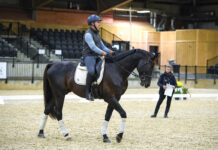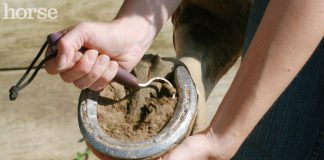Bruce Lachiusa, who has an extensive background as an eventing competitor, a veteran trainer in several English and western disciplines, believes that most problem horses are created by riders who don’t know how to ride. “They pull back on the horse’s mouth, long and hard,” he says. “The mouth eventually goes dead, and the horse gets scared. Then they say it’s a mean horse.”
Shortcuts in training methods can also create problem horses. Without the proper foundation and the slow bringing along of a horse that allows it to develop both mentally and physically, horses may become fearful or resistant to advanced work. “If you start forcing a horse into a frame, they will get sour on you. This happens when owners want results and want them now,” says Lachiusa.
Reschooling
For most problems, rehabilitation consists of reschooling both horse and rider. Explains Lachiusa, “Owners have to take lessons, too, because there’s no sense fixing the horse’s problem unless I can tell them how the problem occurred and how to change their riding style.”
Generally, Lachiusa schools riders for about four or five sessions. Horses require far more time; the minimum is 60 days, with the most severe cases taking up to a year or more.
Reschooling usually involves gentle handling and returning to the basics. There are occasions where he must reestablish respect from the horse, or change its tack, but whatever the situation, he first determines the cause of the horse’s problem.
For example, Lachiusa recently retrained a 6-year-old Thoroughbred mare who would come unglued when ridden. “She had been to three different trainers trying to get broke,” he says. “They could get on her back, but she would go around the arena completely tense, stiff and totally unhappy, and then explode when she couldn’t take it anymore.”
Lachiusa discovered that her tenseness derived from being pushed too hard in her early training. “She was just a mare that needed a very long time to break, and nobody really wanted to do that,” he says.
To defuse her, Lachiusa took her back to beginning training, with longeing under tack to get her used to the saddle and sacking-out to get her less nervous about her surroundings. “We spent a lot of time just doing quiet walks and hacking around fields,” Lachiusa says. “When I finally asked her to work, to come up underneath herself and go forward on the bit, it wasn’t a huge shock. Once she established in her mind that riding wasn’t that terrible and everything was going to be okay, she settled down and trained really nicely.”
With runaways, Lachiusa starts from “ground zero, just like they were never broken. That means halter breaking, everything.” He spends a lot of time retraining runaway horses by using circle patterns. “I use a big fat, soft, full-cheek snaffle that won’t get pulled through the horse’s mouth, and a set of draw reins, and just go out and ride circles,” says Lachiusa. “The horse may be nervous, or go as fast as he wants; I don’t care. He’s eventually going to get bored, so I wait until he settles down, give him a pat, and keep going.”
Horses that rear usually do so because they are evading; blocking; carrying severe, painful bits; reacting to bad hands; or were taught to rear as a game but it got out of hand. There are several ways that Lachiusa rectifies this, depending upon the cause and the individual horse, but usually correction involves going back to classical work: circling, softening and groundwork.
Don’t Emulate the Pros
Lachiusa warns owners to leave most specialized training to the experts. Reschooling involves a lot of experience and skill; retraining rank horses can be dangerous to both the handler and horse if the trainer doesn’t know exactly what he’s doing.
What a rider can do, though, is avoid creating a rank horse in the first place by not rushing a horse’s training or skipping steps, and learning how to sit the horse correctly. Building a good training foundation for both yourself and your horse will help ensure that your horse will never have to make the journey to a “last chance” farm.







Circling, softening and groundwork – great tips. Can you send a more detailed plan to me? I am having this problem with my new horse – I think it’s to evade. The bit isn’t severe – snaffle – and he rides beautifully unless he is near the barn door. Thanks
Hi Donna.
I just stumbled across this website. Never heard of it, and I don’t think they have permission to print my stuff. But, if I can help you I will try.
blhorse1@ptdprolog.net
Sorry,
blhorse1@ptdprolog.net
it seems like all behavior “problems” are actually human problems. i’m a dog trainer, interested in extending that to other species, but i can say for certain that behavior problems can always be fixed with Proper training, and hardly ever with a quick-fix like a shock collar or uncomfortable bit.
I have a 10 y.o. Quarter Horse gelding I purchased 2 months ago. He bolts w/o warning and acts like he’s scared-very fearful of everything-noises, people, other horses, any movements like a bird, a leaf falling. I’m running out of ideas to help him. I want to keep him, but I’m afraid to even get on him. Any suggestions?
I have a 6 year old filly that was a show horse and I cant get her out of the show halter walk and trot and run how do I fix this problem. How do I keep her from raring up while I am ridding her. please help